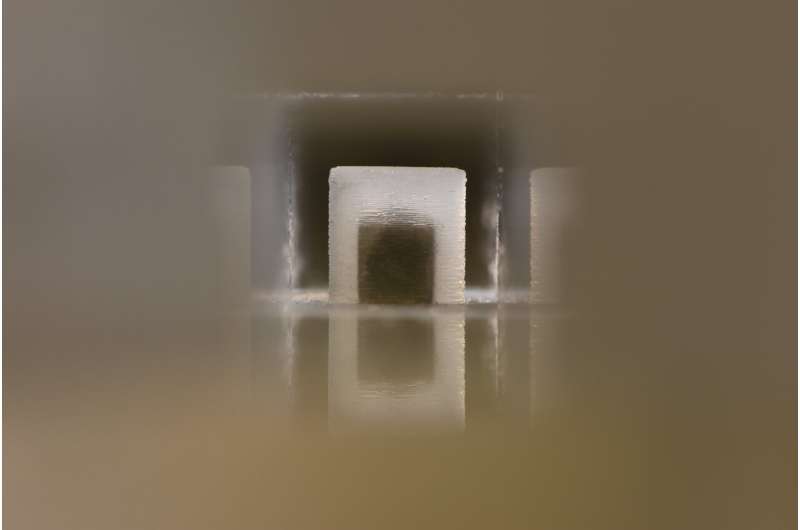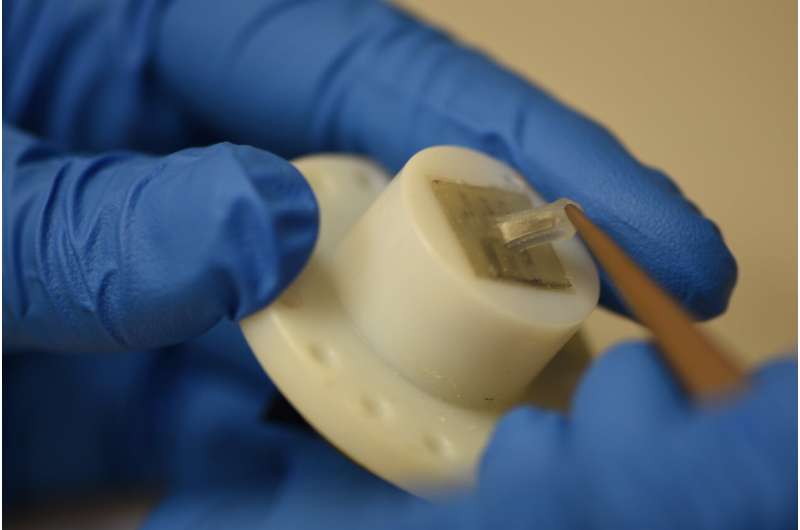July 2, 2019 feature
A bio-inspired flow-sensing cupula for submersible robotics

Nature can be a precious source of inspiration for researchers developing robots and artificial intelligence (AI) systems. Studies in submersible robotics, for instance, have often tried to replicate or incorporate mechanisms observed in aquatic life, such as fish locomotion patterns and shark skin textures.
A team of researchers at the U.S. Naval Research Laboratory and the U.S. Naval Undersea Warfare Center have recently developed a capacitive flow-sensing cupula inspired by superficial neuromasts, which are essentially structures on the body of fish and amphibians that can detect the flow of water. This cupula, presented in a paper published in MDPI, exhibits a high sensitivity of 0.05 picofarad per millimeter (pF/mm) and could be applied to a variety of robots and vehicles designed to be deployed underwater.
"The U.S. Naval Research Laboratory, along with many other institutions, is exploring nature-inspired means to achieve increased efficiency and maneuverability in underwater robots," Charles Rohde, one of the researchers who carried out the study, told TechXplore. "In essence, creating an artificial fish offers many benefits over traditional propeller-driven designs. If we look at biological counterparts, though, we see that their success is due to more than just the mechanics and body motion; fish have arrays of sensors along their bodies."
Fish have a series of so-called lateral line sensors that provide flow condition feedback, allowing them to orient themselves underwater and detect nearby objects. Rohde and his colleagues wanted to replicate these sensors and mimic their properties to enhance the performance of underwater vehicles.
The biological cupulas observed in fish are comprised of gel embedded with sensor hairs, which are attached to the aquatic animal's brain via a series of nerves. The artificial cupula developed by the researchers, on the other hand, is made up of silicone rubber embedded with liquid metal sensing plates, which are attached to a microcontroller using wires.
A further difference between naturally occurring cupulas and the artificial one developed by the researchers is that while the former employs electrochemical signals, the latter is capacitive (i.e. like smartphone touchscreens, it relies on changes in electric fields). In contrast with touchscreens, the bio-inspired device does not interact with external objects (e.g. human fingers). Instead, it consists of liquid metal plates moving and deforming relative to one another.
"The liquid metal (gallium-indium) plates form two capacitive sensors that deform based on forces imparted on the silicone cupula by fluid flow," James Wissman, another researchers involved in the study, explained. "As the cupula deforms, the liquid metal plates inside move closer or farther from each other, changing the capacitance between them. A microcontroller records this change in capacitance, which can be related to the outside fluid flow rate through experimentation and mathematical modeling."
The capacitive sensors developed by the researchers have a high sensitivity and can also be arranged in arrays. For instance, dozens of these sensors could be arranged across an underwater robot in a lateral line, in order to capture and track water flow characteristics. These sensing cupulas are soft; thus they can be integrated with artificial skin materials without adding rigidity to bio-inspired machines.

"There are several other cupula- and hair-based flow sensors published in the literature, but we were surprised to find only one other underwater, seal whisker-inspired example that was capacitive in nature," Rohde said. "Our results show that capacitive sensing is a very promising approach, and we hope that our publication will encourage others to explore this method."
Rohde, Wissman and their colleagues fabricated their bio-inspired sensor using lost wax and vacuum injection techniques. They then carried out a series of preliminary tests to evaluate its performance.
Compared to other capacitive devices, their sensor incorporates transducers into the cupula itself, rather than at its base. In their evaluations, this particular aspect of the sensor's fabrication proved to be very effective, leading to more advanced sensing capabilities than those observed in previously developed capacitive devices.
"Aside from the sensor itself, another important aspect is the fabrication process," Wissman said. "To create such a complex structure inside of a small silicone structure, we used a unique combination of sacrificial molding (think lost-wax casting) and vacuum-injection of liquid metal. This could easily be extended to other devices, such as complex 3-D wiring or antennas."
The sensing device developed by Rohde, Wissman and his colleagues could have a wide variety of applications in the field of submersible robotics, as it enables the development of robots that can navigate underwater environments more effectively. In their future work, the researchers plan to miniaturize their device, which is currently 5mm tall; 50 times bigger than the neuromasts observed in fish.
A smaller version of the sensor could allow for a more direct measurement of boundary layer flow conditions, even closer to a robot's water-facing surface. In order to miniaturize the sensor, however, the researchers will need to change their fabrication methods.
So far, Wissman and his colleagues have primarily focused on steady (or slowly changing) flows of water, but superfast flow variations (i.e. >1,000-10,000 times per second) associated with turbulence and vortices could provide deeper insight about a robot's surrounding environment. In their upcoming studies, the researchers would hence like to broaden the scope of their work by including these flow variations and looking at faster data acquisition techniques.
"We also plan to assemble an array of artificial cupulas—an artificial lateral line—that can be attached to a submersible robot," Wissman said. "The culmination of this project would be to watch an autonomous robotic fish, with the aid of our embedded sensors, successfully navigate a pool with obstacles and currents."
More information: James P. Wissman et al. Capacitive Bio-Inspired Flow Sensing Cupula, Sensors (2019). DOI: 10.3390/s19112639
A capacitance-based Whisker-like artificial sensor for fluid motion sensing. DOI: 10.1109/ICSENS.2010.5690637. ieeexplore.ieee.org/document/5690637
© 2019 Science X Network



















